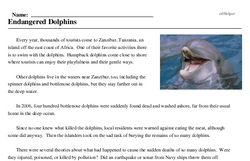Endangered Dolphins
Every year, thousands of tourists come to Zanzibar, Tanzania, an island off the east coast of Africa. One of their favorite activities there is to swim with the dolphins. Humpback dolphins come close to shore where tourists can enjoy their playfulness and their gentle ways.
Other dolphins live in the waters near Zanzibar, too, including the spinner dolphins and bottlenose dolphins, but they stay farther out in the deep water.
In 2006, four hundred bottlenose dolphins were suddenly found dead and washed ashore, far from their usual home in the deep ocean.
Since no one knew what killed the dolphins, local residents were warned against eating the meat, although some did anyway. Then the islanders took on the sad task of burying the remains of so many dolphins.
There were several theories about what had happened to cause the sudden deaths of so many dolphins. Were they injured, poisoned, or killed by pollution? Did an earthquake or sonar from Navy ships throw them off course?
No evidence of injuries was found on the dolphins. Scientific tests ruled out poisoning or pollution as causes of the dolphins' death.
That left scientists to wonder if something had interfered with the dolphins' echolocation, the process they use to navigate. Dolphins give out high-pitched sounds that bounce off objects and return. These sounds tell dolphins where objects are located. Dolphins use echolocation to guide them as they travel through the darkness of the deep ocean, in the same way that bats use echolocation to find their way in a dark cave.
Since echolocation is so important to dolphins, it was suspected that some unusual sound like an undersea earthquake or Navy sonar caused the dolphins to get lost. An event like that may have interfered with the dolphins' own sonar-like navigation system. Maybe it confused or frightened the dolphins.




